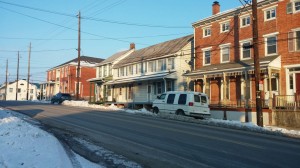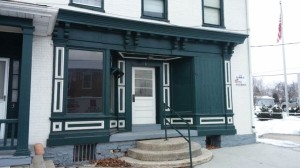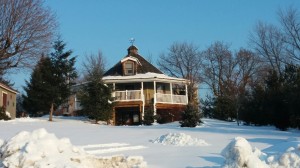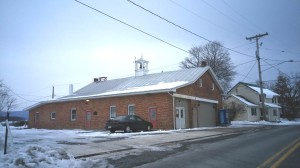Given I routinely speak to agencies, applicants, and the public about historic architecture, I was a bit surprised by the presence of sweaty palms and butterflies as I prepared to talk to a new audience, a group I assumed would exhibit short attention spans, emotional reactivity, and call-it-like-you-see-it attitudes while I struggled to make even the most basic architectural principles interesting. As is the case with much of life, reality provided distant from expectations, and I was reminded of a very basic but important principle I believe worthy of sharing in a blog posting: the connection between memory and place and identity.
After agreeing to be a part of Career Day at my son’s daycare earlier this year, I realized I wasn’t even sure my son understands what I do, let alone how to describe it to a class of preschoolers. So I gave some serious thought as to how to hold the attention of three-, four-, and five-year olds. In my experience, the keys to a successful presentation are an engaging speaker, visual aids, and audience participation. Not willing to don a clown suit or super hero costume, I decided to focus my discussion on visual aids and audience participation. In preparation I drove around and photographed many of the buildings in Newburg, the small community in western Cumberland County where the preschool is located. Founded nearly 200 years ago, the National Register-eligible Newburg Historic District (Key No. 128838) includes a church, a cemetery, a community park, a former school, a firehouse, a store, a former hotel/boarding house, and numerous two-story dwellings, including many notable examples of brick-clad log construction. The small hamlet is concentrated around Main Street and five cross streets and is surrounded by a landscape that remains largely agricultural.
We began with a discussion of the basics:
- What are buildings made of? rocks, sticks, Legos, straw, plastic (I think they meant vinyl siding) and bricks;
- What shapes are buildings? rectangles, squares, triangles, and octagons (Newburg has an octagonal school house);
- How can the way buildings look tell us about what goes on inside? i.e., large doors of the firehouse, steeple of the church, big windows of the stores, and so on.
What seemed to truly resonate with the children were pictures of the places they associated with the events of their short lives. A red headed boy remembered getting his first big-boy hair cut in a beauty salon on Main Street. Another child from a nearby farm recognized a photograph of his Daddy’s chicken house and told us about collecting the eggs. There were stories of field trips to the post office and pizza shop and recollections of time spent at the firehouse. While it seems to be a very basic concept, the recalled memories of the children were tied to specific places in the community. It was obvious from their pride in sharing their stories that these places had in some way given the children a sense of self, telling them who they are, and possibly who they will be as adults.
I recall my own childhood growing up on “the farm”, a property in possession of my family for six generations. I have many memories of that landscape and its buildings, including some that are not my very own but those passed down through the generations as family folklore. I remember a day in the barn with my Dad when he pointed out the name of my great-great grandfather on a wall between the threshing floor and haymow: “Eli Coffelt, 1867” read the painted letters, telling the story of the man who erected the timber-frame structure in place of an earlier barn that had burned in the Civil War. For me, over time that barn has become a symbol of overcoming and strength. It serves as an immediate connection to my past and my family and in many ways is uniquely tied to my identity. If it was ever lost or destroyed, I believe a part of my identity would be damaged, although the farm would certainly live on in my memory.
While preservationists consider historic resources from the viewpoint of significance for historic events or architecture, that perspective is often more disconnected from the resource than the concept of memory. Through memory we have a personal and immediate coalescence with a place, no matter where we are. Memories passed down over generations can ensure that our sense of history and place endure, telling us where we come from and possibly where we are going. Ultimately, our connection to place is emotional which is why certain places remain compelling even after they are gone from the landscape.
When conducting review of the effect of state or federally sponsored projects on historic properties, I often have the opportunity to interact with members of the public and understand the importance of memory in creating sense of place and identity. For community institutions, such as schools, post offices, court houses, and hospitals, collective memory has a role to play in project review; a community’s identification with these resources ensures greater public interest in preservation, rehabilitation, or commemoration. Individual memory of place can also influence public interest and involvement. I am reminded of a recent consulting party meeting where a seven-year-old boy actively participated in the discussion, asking questions about the impacts of the project on “our bridge”.
Several months ago I shared with you guidelines for developing more meaningful mitigation for state or federally sponsored projects that adversely affect historic resources. Among the criteria for meaningful mitigation that were presented were “Consider mitigation that enhances the knowledge and protection of historic properties” and “Consider the public benefit”. Our knowledge of historic properties is often limited to historic resources survey forms or studies. This type of documentation may provide the history of a property but it is a less personal story. In an effort to better understand how places interfaced with people, when appropriate, our office has begun utilizing oral interviews as a mitigation tool. Interviews with individuals who had significant connections to historic properties enable us to capture memories of individual places, including day-to-day activities, changes in operations over time, or the more personal details of important events that occurred there. As part of an effort to consider the public benefit of mitigation it is our intention that some of these interviews, especially those specific to public spaces, will be made available online at a future date.
In conclusion, the preschoolers in Newburg reminded me that we should not to lose sight of the importance of memory in creating sense of place and identity. We should carefully consider the importance of memory and its possible use as a tool for promoting public interest in historic properties as well as sensitive stewardship and preservation of our built environment for generations yet to come.
If you have stories of places that embody your identity or how memory has resulted in a preservation outcome, please share.
Comment Policy
PHMC welcomes and encourages topic-related comments on this blog. PHMC reserves the right to remove comments that in PHMC’s discretion do not follow participation guidelines.
Commenters and Comments shall be related to the blog post topic and respectful of others who use this site.
Commenters and Comments shall not: use language that is offensive, inflammatory or provocative (this includes, but is not limited to, using profanity, obscene, or vulgar comments); disparage other commenters or people; condone illegal activity; identify the location of known or suspected archeological sites; post personal information in comments such as addresses, phone numbers, e-mail addresses or other contact details, which may relate to you or other individuals; impersonate or falsely claim to represent a person or an organization; make any commercial endorsement or promotion of any product, service or publication.
If you would like to comment on other topics not related to this blog post but related to PHMC, please fill out the PHMC Contact Us Form.





Leave a Reply